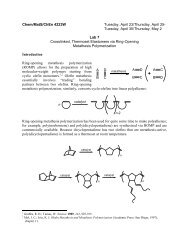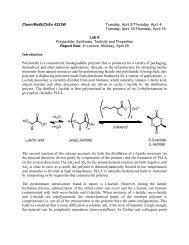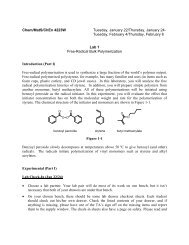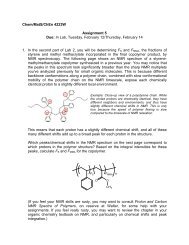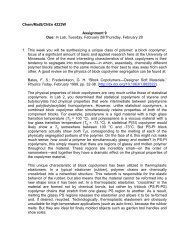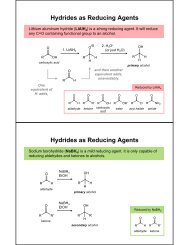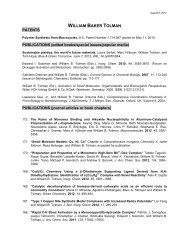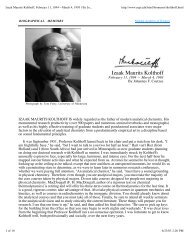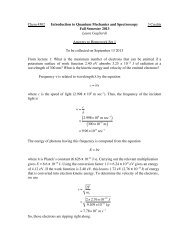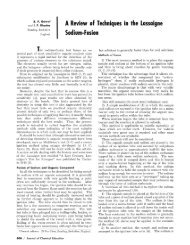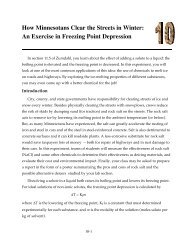Ion-Selective Electrodes With Ionophore-Doped Sensing Membranes
Ion-Selective Electrodes With Ionophore-Doped Sensing Membranes
Ion-Selective Electrodes With Ionophore-Doped Sensing Membranes
Create successful ePaper yourself
Turn your PDF publications into a flip-book with our unique Google optimized e-Paper software.
<strong>Ion</strong>ophore-doped sensing membranes 2551<br />
(a)<br />
(c)<br />
S<br />
N<br />
N H<br />
H<br />
(b)<br />
N<br />
H<br />
N<br />
S<br />
This is often also accompanied by typically minor but sometimes<br />
larger changes in selectivity. 1, 3 If a different polymer<br />
or a different blend of polymer and plasticizer that dissolves<br />
the ion-selective components better cannot be found, the<br />
more cumbersome approach of synthesizing a more soluble<br />
compound has often to be taken. This may involve the<br />
attachment of unbranched or branched alkyl substituents to<br />
the ionophore or ionic site, or the reduction of compound<br />
symmetry. Alternatively, the ion-selective components may<br />
be covalently attached to the polymer backbone. 64<br />
To form a hydrophobic membrane suitable for use in<br />
potentiometry, a polymer cannot have that many polar<br />
groups that it becomes soluble in water. Even for a polymer<br />
of negligible solubility in water, polar substituents can be a<br />
disadvantage, though. In an ideal ISE membrane, the ion of<br />
interest is bound selectively by the ionophore, and any other<br />
type of ion undergoes only minimal stabilizing interactions<br />
with the membrane components. Evidently, after spending<br />
a lot of effort to design ionophores that strongly bind the<br />
ion of interest and form no or only very weak complexes<br />
with other ions, it is not desirable if other (potentially<br />
interfering) ions bind to the polymer or plasticizer, lowering<br />
the selectivity of the ISE membrane. 62 From this point of<br />
view, membrane matrixes of low polarity are desirable. The<br />
ultimate limit of selectivity may arguably be reached with<br />
fluorous matrixes, which are the least polar of all known<br />
condensed phases. Indeed, fluorous membrane ISEs have<br />
16, 65–67<br />
shown exceptional selectivities.<br />
Figure 13 <strong>Ion</strong>ophore aggregation in ISE membranes: Dark<br />
field microscopy images of membranes containing a bis-thiourea<br />
ionophore (c) and 0 or 50 mol% cationic sites (a and b, respectively)<br />
after exposure of the membranes to aqueous sulfate solutions.<br />
(Reproduced from Ref. 63. © Wiley-VCH, 2005.)<br />
The matrix formed by the polymer or the blend of polymer<br />
and plasticizer must dissolve all the components that<br />
provide the ISE membrane with selectivity, that is, the free<br />
ionophore, the ionophore complex, and the ionic sites. In<br />
the case of an electrically neutral ionophore, this means that<br />
precipitation of not only the ionophore itself but also salts<br />
formed by the ionic sites and the ionophore complex must<br />
be avoided. In the laboratory, the formation of crystalline<br />
precipitates is often readily recognized with the naked eye.<br />
Because the aggregation of membrane components can also<br />
result in small crystals or noncrystalline aggregates that may<br />
be easily overlooked, the routine observation of ISE membranes<br />
containing new ionophores or ionic sites with an<br />
optical microscopy is recommended (Figure 13). 63 When<br />
a new ionophore or ionic site has been synthesized but is<br />
found to be affected by solubility problems, a very simple<br />
approach to deal with this problem is to choose a different<br />
polymeric matrix with which precipitation can be avoided.<br />
3.1.5 ISEs with internal solid contacts<br />
The conventional ISE setup with an inner filling solution<br />
separating the ion-selective membrane from an internal reference<br />
such as a AgCl-coated silver wire is very versatile<br />
and can be easily set up in the laboratory, it but brings<br />
along a number of disadvantages. These include insufficient<br />
resistance toward high pressure as encountered in sterilization<br />
and deep-sea measurements, and frailty of miniaturized<br />
sensors due to evaporation of the inner filling solution<br />
or occurrence of osmotic pressure differences across the<br />
ion-selective membrane. The latter is a major factor limiting<br />
the miniaturization of ISEs. Moreover, transmembrane<br />
ion fluxes worsen detection limits and can only be suppressed<br />
with careful optimization. Not surprisingly, various<br />
efforts to eliminate the inner filling solution have been<br />
made and are briefly described in the following paragraphs<br />
to highlight the close relationship of the resulting devices<br />
to conventional ISEs (Figure 14). However, it needs to be<br />
emphasized that these solid-contact devices owe their function<br />
to exactly the same control of the sample–membrane<br />
phase boundary potential using ionophores and ionic sites as<br />
the conventional ISEs with an inner filling solution. While<br />
solid contacts have the promise to significantly enhance the



